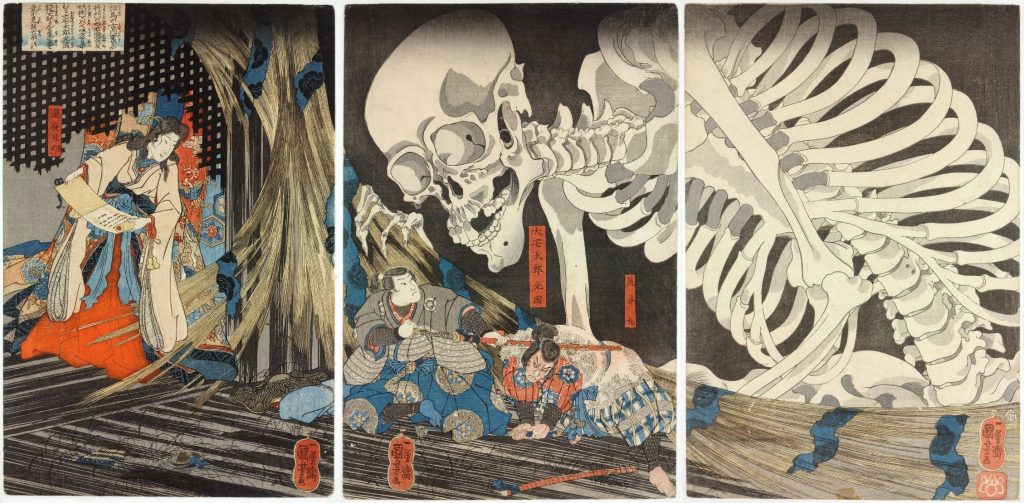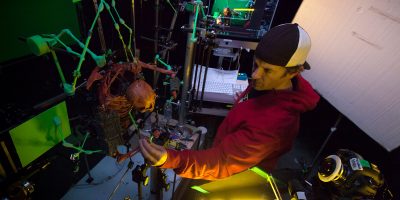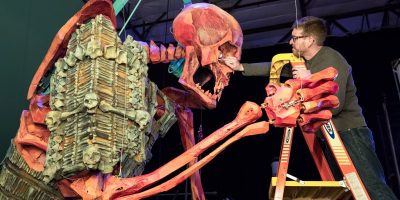For Kubo and the Two Strings, the team at LAIKA built the largest stop-motion puppet ever built, weighing 400 lbs. and standing at 16 feet from head to toe with a 23-foot wingspan. The lower half and upper half had to be filmed separately, with most shots capturing the upper body/torso.
Watch a breakdown of clips from the Hall of Bones sequence:
For some scenes, a one-sixth-scaled Skeleton was used; standing just over 2.5 feet tall, this is also among the largest stop-motion puppets ever made. It is an impressive feat, especially considering the fact that in the beginning it was going to be at a much more traditional scale.
The inspiration for the Skeleton was derived from the famous triptych woodblock print “Takiyasha the Witch and the Skeleton Spectre,” by Japanese artist Utagawa Kuniyoshi, in which he depicted the 10th-century princess Takiyasha summoning a skeleton spectre to frighten an adversary.

Building the skeleton
“Early on, in regards to the Hall of Bones skeleton, we were really trying to go ‘Harryhausen’ with it,” says vfx supervisor Steve Emerson. They initially were planning to build a smaller scale three foot puppet and then do scale comps in order to tell the story. “The problem was that it wasn’t just a puppet, it was also very much a set of characters being grabbed by this thing, they’re running across the surface of this thing,” says Emerson. “We also knew we were going to end up having to build components of the skeleton that were going to be full scale.”
The decision was made to only build a full scale puppet for key shots, meaning that they would only have to create bits and pieces of the skeleton at full scale. The problem was, as the team broke down the script, they realized that the portions they needed at full scale would pretty much combine to make up the full puppet. “At that point, everybody’s like, ‘Let’s do it,'” says Emerson. “There’s this overwhelming insanity and enthusiasm at the studio where everyone says ‘We’re going to build the largest stop motion puppet that’s ever existed, and it’s going to be awesome.'”

During the design process of the puppet, the preferred software of the various departments created a bit of a hitch in the workflow. The art department uses Z-brush and the rigging department uses Inventor. To go back and forth between the two departments (which is a natural part of the process), they actually need to run the files through an older version of Maya to translate from one app to another.
Once the design was done, the files were sent out to have the parts cut out in industrial cut high density foam. These foam pieces were painstakingly covered and painted to achieve the final look.
In order to animate the puppet on the X,Y, and Z axes, LAIKA’s Steve Switaj said that they first went in search of a “giant-ass robot” to move the skeleton. But it was the controllers on the robots that ended up being the primary reason they couldn’t use them: the controllers couldn’t interact with their pipeline. There were also other considerations, such as the requirement to install a concrete pad to anchor the robot…and that wasn’t going to happen on the stage.
The next solution explored was to use a Hexapod, which is a mid-sized motion-control table. It is a platform with three pairs of hydraulics that allow the platform to move in X,Y, and Z as well as pitch, roll, and yaw. This ended up being able to serve their purposes, so they built one over a span of 27 days.

The arms of the Giant Skeleton were incrementally driven via independent rigs, suspended from the ceiling and counter-weighted like an enormous marionette. Each of his hands weighed six pounds. The elbow locks of the Skeleton, made from automobile brake pads, had to be replaced three times over the course of the shoot.
Instead of the traditional ball joints for stop-motion puppets, the arms and head were secured with clusters of magnets to provide maximum range. 70 unique swords were made for the skull, and over 1,000 bones were used to make the armor for the torso.
Animating the Giant Skeleton was a different beast from LAIKA’s normal puppets. Normally, they are able to record three seconds of animation per week, per puppet. For this model, due to its size and the tedious nature of animating, they were able to record about one second of animation per week.
All in all, it took six months to build the skeleton with 49 seconds and 5 five frames worth of footage from it making it into the final film.
Compositing
The visual effects team at LAIKA has grown over the years, as more and more is done to support the in-camera animation, but the team is still not very large. “Compared to what we did on Coraline, which was largely practical, to where we are now at the end of Kubo, essentially the head count of the visual effects team is pretty similar,” says Emerson. “We do not have a lot of time, so a lot of it just comes down to what do we need to be able to tell the story that we want to tell, and does it look right while we’re putting this visual up in front of the lead directors?”
In the case of the Hall of Bones, a tremendous amount of resources were going into the building of an enormous puppet while the vfx team was plotting out how to best attack the environments. They decided to build a physical ground plain that the Kubo, Beetle, and Monkey puppets could run around on and interact with, while visual effects would create the balance of the environment in CG.
https://youtu.be/kqChBqQv1Y4
For practical reference, they built a section of one of the eight walls that make up the giant octagon which is the Hall of Bones. This section was used for closeups in the film as well as lighting reference for the vfx team to take it on set under the physical lighting and take reference photos as well as see in person how the surface reacts to light. “Every component that would make up the surface of each of those walls was provided to us in a physical form from the art department,” says Emerson. “We took all of those physical materials and we digitized them and we replicated them and we built the walls and we built that octagon.”
The most challenging aspect of the Hall of Bones was the lighting, says Emerson. For starters, it was the variety of light sources in the scene — from the moonlight entering from above giving cool blue kicks to elements in the scene, to the warm furnace-like glow emanating from inside the skeleton. The good news is that since the vfx team is across the LAIKA lot, they can easily schedule time to take photographic reference and HDRs on-set. “It’s amazing,” says Emerson, “We get the entire reference for the scene with very little effort.”
The bad news, so to speak, is that over a two year production those lighting setups aren’t exactly locked in, to say the least. It’s a combination of time and progress and things changing, as well as the inevitable creative decisions. “It’s all very artistically driven at the shot level,” says Emerson. “When you drop those HDRs in, all bets are off.”
In the end, they treated it with a more traditional CG comping approach using multiple lighting passes. For the final environments, it is the ground plain that the puppets are interacting with that is physical, and the rest of the Hall of Bones is fully computer generated. “We had the HDR, we had a warm bottom-lit source, we had the blue moonlight from above, we had a bounce, and specular diffuse. We generated a lot of AOV’s and put it in the hands of the compositors.”
That two year production process also impacts visual effects as well, since much can change in post over time. “You’re talking about multiple compositors over the course of two years,” says Emerson. “It really becomes about management of those images, how do we make sure that everything is consistent? Fortunately, we had a really strong lead compositor,Tilman Paulin, who was able to stay on top of it.”
Once the vfx team completes a sequence, it is assigned to a lead compositor or senior artists. They then go through it and do a final pass to make sure that everything is consistent before running it past the director. Once approved, it is delivered for DI.
“Hopefully, as the cliché goes,” says Emerson, “if you’re successful in visual effects, nobody knows you ever did a thing.”
